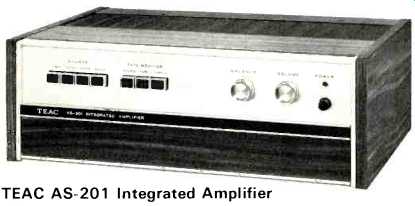
MANUFACTURER'S SPECIFICATIONS
Power Output: 50 watts per chan., 8 ohm load.
Distortion: Less than 0.5% THD at 50 watts; less than 0.5% IM at 40 watts.
Frequency Response: 20 to 80,000 Hz +0, -1 dB, main amp roll-off at 30 Hz in preamp.
Power Bandwidth: 20 to 30,000 Hz.
Sensitivity: PHONO 1 and 2, 2 mV; AUX 1 and 2, TUNER, TAPE, 130 mv.
Dimensions: 16 1/2 in. W by 11 3/4 in. D by 6 1/2 in. H.
Price: $349.50.
The TEAC AS-20I is an integrated amplifier having most of the usual facilities plus extra features for the tape recording enthusiast. As this company has built up its reputation in the tape recorder field, this is not really surprising! As can be seen from the photograph, the front panel looks unusually clean and uncluttered because most of the controls are hidden away behind the hinged lower section. The push buttons on the left are for TUNER, PHONO, and AUXILIARY inputs and the group of three is designated TAPE MONITOR. These permit two tape recorders to be used with monitoring of the signal source and from the tape (if the recorder has independent heads). When dubbing from one recorder to another, the tape recorder for playback of the original tape is connected to one of the auxiliary inputs.
The two main controls are VOLUME and BALANCE, and on the extreme right is the ON/OFF switch and indicator. Behind the lower panel, the controls are as follows: slide switch for two PHONO inputs, stereo mode, bass, treble, tone control cancel, high and low filters, loudness, and then the speaker switch. A socket for headphones is located on the right. On the rear panel are three power receptacles (one switched, two unswitched), thermal circuit-breakers, and the various input and output sockets, which include a DIN socket for tape recorders. A little crowded, this panel! The speaker terminals are heavy-duty spring connectors, and there is an output socket for center channel. Note in Fig. 2 that under the circuit-breaker reset buttons are sockets for main amplifier and preamplifier with removable connecting links. This is a useful point for the insertion of a decoder, electronic crossover, or equalizer, if so desired. I did, in fact, use a Soundcraftsmen 20-12 here and no detectable increase in noise or distortion was noticed. Figure 1 shows the view inside.
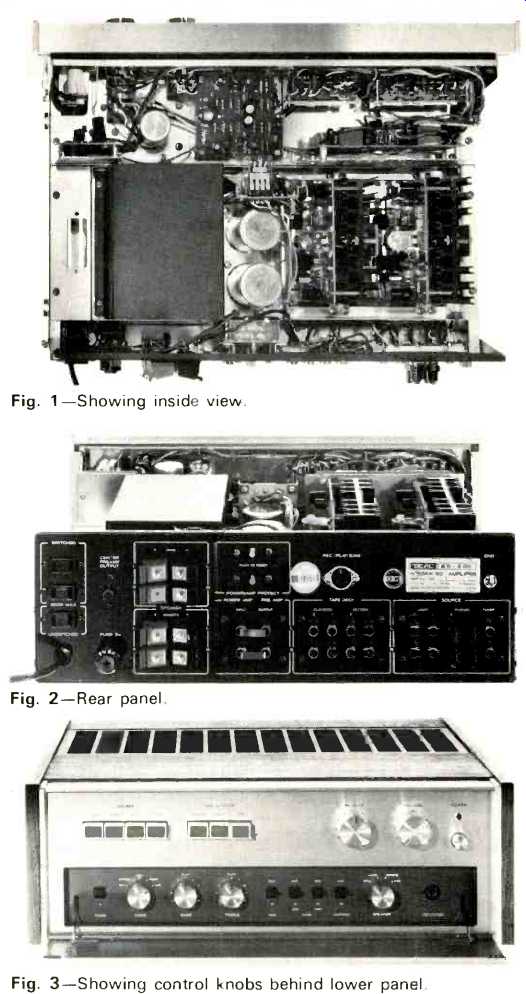
Fig. 1-Showing inside view.
Fig. 2-Rear panel.
Fig. 3-Showing control knobs behind lower panel.
Circuit Description
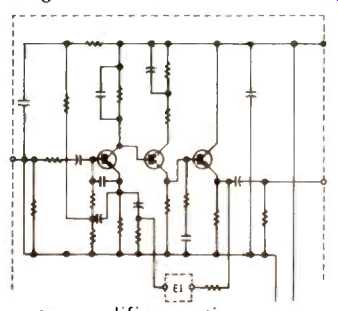
Fig. 4-Phono preamplifier section.
The first stage is fairly conventional, using three transistors in an NPN, PNP, NPN configuration, as shown in Fig. 4. Phono equalization is performed by the feedback loop at E1. The low impedance output from this stage is taken to another three-stage amplifier. The first transistor is an FET and high level inputs are taken from this stage. After this three-transistor amplifier comes the tone-control amplifier which uses three more transistors plus an emitter-follower that feeds the power amplifier section. A differential input stage is used here-an arrangement which is now becoming standard practice. The two silicon NPN output transistors are driven by a complementary pair and output is taken to the speaker terminals via a four-transistor circuit which operates the cutouts.
A muting circuit prevents current reaching the speakers for about three seconds after switching on. Not only does this minimize the possibility of damaging fragile tweeters, but it stops that annoying switching thump too. The stabilized power supply uses two transistors and the unstabilized voltage for the output stage is just over 40.
Performance
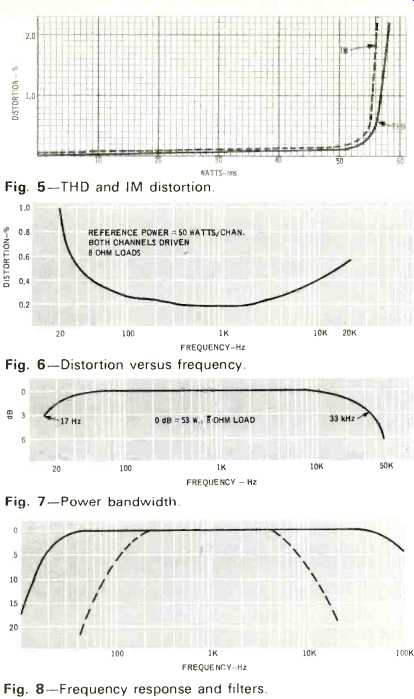
Fig. 5-THD and IM distortion.
Fig. 6-Distortion versus frequency.
Fig. 7-Power bandwidth.
Fig. 8-Frequency response and filters.
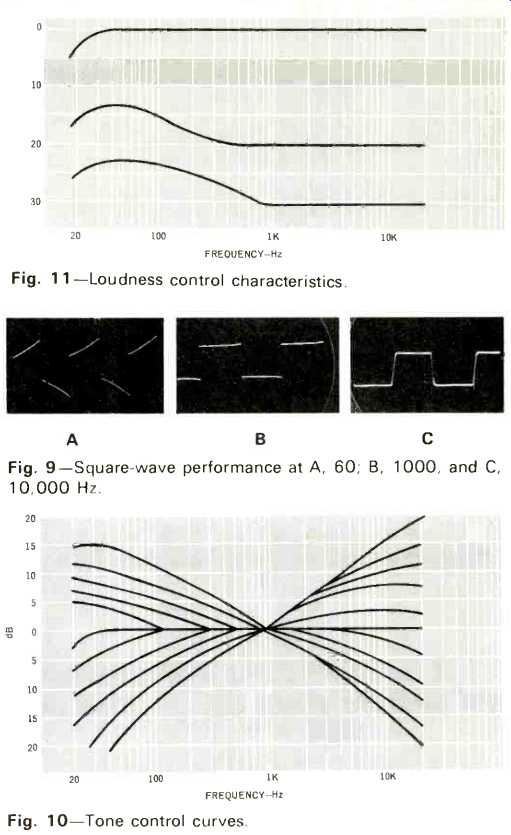
Fig. 9-Square-wave performance at A, 60; B, 1000, and C, 10,000 Hz.
Fig. 10-Tone control curves.
Fig. 11-Loudness control characteristics.
Power output came out at 55 watts per channel with half power points at 17 and 32,000 Hz. (See Figs. 5 and 7). The distortion versus frequency curve is shown in Fig. 6. Frequency response is shown in Fig. 8 (taken at the tuner input), and square wave performance at 60, 1000, and 10,000 Hz is shown in Fig. 9. The low frequency waveform shows the effect of 30 Hz roll-off. High frequency square-wave characteristics were checked with the tone controls in and out of circuit but there was no detectable difference (with the controls set flat) apart from a complete phase reversal. Neither, for that matter, was there a measurable change in distortion.
Stability was checked with an electrostatic speaker and found to be completely satisfactory. Filter characteristics are shown in Fig. 8, and tone control curves in Fig. 10. These are both step-type controls giving about 2 dB change per step at 40 Hz and 10,000 Hz. The effect of the loudness control (Fig. 11) was much less drastic than most, giving a maximum lift of 7 dB at the low end with 30 dB overall attenuation. Hum and noise measured 71 dB, unweighted at the PHONO inputs (grounded) and 84 dB for AUX, TUNER, and TAPE positions.
Residual noise (volume control set at minimum) was-89 dB referred to full rated output. Phono sensitivity measured 2.1 mV with overload at 145 mV--very satisfactory. TUNER and AUX sensitivity was 140 mV. Crosstalk was-55 dB at 1000 Hz and 49 dB at 10,000 Hz.
These days, an amplifier with an output of some 50 watts per channel is rated as a medium power unit, but a total of 100 watts is certainly ample for most people! A Shure V-15 Mk II was used for most of the listening tests and the PHONO 1 input was used. The second phono input has a stated impedance of 80 k-ohms-too high for the majority of cartridges in common use and a parallel 100 k-ohms resistor would be needed for accurate matching. This should be mounted inside the amplifier and a low-noise type ought to be used. A tape recorder was also used with the AS-201 and recordings were made simultaneously on a cassette machine-a TEAC A-24. An interesting comparison greatly facilitated by the provision for two recorders mentioned earlier. The protection circuits worked very well; in fact, great care had to be taken when testing with full sine wave power because of the operation of the circuit breakers! Summing up, the AS-201 is a fine medium-power amplifier, specially recommended for the tape enthusiast.
-T.A.
=================
(Adapted from Audio magazine, Mar. 1972)
Also see:
TEAC Model AS-100 Integrated Amplifier (Equip. Profile, Jan. 1973)
Teac Model AS-200U Amplifier (Equip. Profile, Apr. 1970)
TEAC Model AT-100 Stereo FM Tuner (Jun. 1973)
= = = =